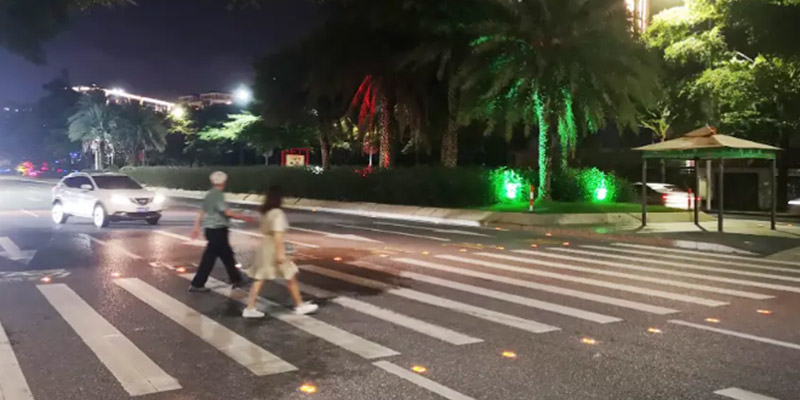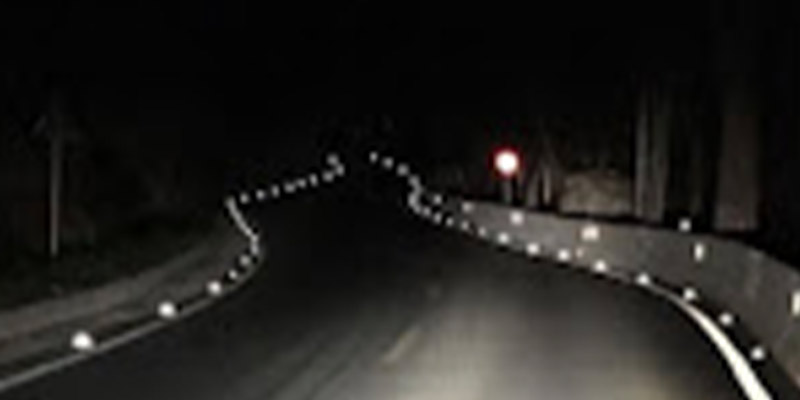Last year in rural Australia, a driver nearly crashed into a cliff while navigating a sharp curve in foggy night conditions. It was the faint red glow emitted by solar road stud lights along the roadside that allowed him to swerve out of harm's way in time. This is not an isolated incident: World Road Association data shows that sections equipped with solar road studs experience 35%-50% fewer nighttime accidents compared to those using traditional reflective studs.
However, not all solar road studs deliver such results. Cheap, low-quality products often fade within 6 months, fail during rain, or even stop working in extreme temperatures. If you're planning to upgrade road safety infrastructure—whether for neighborhood paths, busy highways, or scenic trails—this article dissects real-world applications of solar road studs and outlines seven essential considerations for selection in 2025.
Data speaks volumes, but actual projects demonstrate how solar road studs solve specific challenges. The following 3 cases demonstrate their value:
Roads in Nepal's Himalayan region are notorious for dense fog (nighttime visibility as low as 10 meters) and extreme cold (winter temperatures dropping to -15°C). Before 2023, nighttime accidents averaged 12-15 per month.
After installing HA-RS-180 solar road stud lights (equipped with lithium iron phosphate batteries rated for -30°C to +70°C and 15,000 candela LED brightness), monthly accidents dropped to 3-4. Local officials stated: “Even during two consecutive days of dense fog obscuring the sun, the stud lights maintained illumination for 14 hours. Drivers can now see curves clearly from 200 meters away.”
Kenya's Mombasa-Malindi coastal highway faces dual challenges: corrosion from sea-borne salt spray and erosion from annual rainfall averaging 1,500 mm. Traditional reflective road studs lasted only 8-10 months before failing due to rust or being washed away.
In 2024, local authorities switched to solar-powered stud lights (IP68 waterproof rating, aluminum alloy housing with anti-salt coating). After 12 months, 92% remained operational, slashing maintenance costs by 60% (eliminating monthly replacements).
In school zones near São Paulo, Brazil, speeding vehicles posed constant threats to children walking to school. Conventional stud lights failed to effectively alert drivers to slow down until solar-powered pedestrian stud lights with slow-flashing mode (HOAN HA-P10 model) were installed locally.
These stud lights flash red light every 1.5 seconds near crosswalks. Six-month tracking data showed a 40% reduction in driver speeds in the area, and the number of near-miss incidents involving child pedestrians dropped from 18 per month to just 2. A local school principal remarked, “Parents now feel confident letting their children walk to school alone.”

Not all solar road stud lights deliver the effectiveness seen in the above case. To avoid wasting funds, focus on verifying these 7 key features:
Standard lithium batteries are prone to failure in high temperatures (+45°C+) or low temperatures (-10°C-). Lithium iron phosphate batteries, however, operate reliably between -20°C and +70°C, with a lifespan of 5-8 years (compared to 1-2 years for standard lithium batteries). Always require suppliers to provide battery temperature endurance test reports and reject products without verifiable specifications.
IP67 is merely “acceptable,” while IP68 is the “bulletproof standard” for road applications. IP68-rated road stud lights can withstand 30 minutes submerged in 1.5 meters of water without leakage and offer complete dustproofing—critical for rainy seasons or poorly drained road sections. Products labeled only as “waterproof” without an IP rating should be immediately excluded.
Below 8,000 candelas: Difficult to see in fog or rain;
Above 15,000 candelas: Causes glare at night, impairing driver vision.
The 8,000-15,000 candela range is the “golden zone”—ensuring visibility from 500 meters away without causing eye strain.
Polycrystalline silicon panels lose 20% efficiency in high temperatures (above 60°C), while monocrystalline silicon panels maintain stable performance even in heat. Combined with an anti-reflective (AR) coating, they absorb 30% more sunlight, making them ideal for overcast days or shaded road sections.
Pure plastic housing: Cracks within 6 months due to UV exposure and vehicle rolling;
Aluminum alloy + UV-resistant polycarbonate: Withstands over 30 tons of pressure (meets truck traffic requirements) and retains color for 5 years. Opt for products with casing thickness ≥1.5mm; thinner casings deform easily.
Road stud lights must illuminate all night even during overcast conditions. Premium products offer 10-14 hours of backup, while budget options often extinguish after 4-6 hours (leaving roads unmarked during early morning hours). Request suppliers to provide “darkroom endurance test videos” to verify actual runtime.
European market: Requires CE certification (meets safety regulations);
African Market: SONCAP (Nigeria), KEBS (Kenya), etc. (to avoid customs clearance issues);
Global Standard: RoHS certification (toxics-free, mandatory in most countries).
Products lacking any certification risk customs detention or safety non-compliance—avoid purchasing them.

Even with the above knowledge, buyers often incur losses due to these errors—take special note:
Misconception 1: Choosing Only the Cheapest Products
A $10 solar road stud light may seem economical, but 50% may fail within six months. Premium products priced $18–25 last over five years, averaging just $3–5 annually. Long-term, the “hidden costs” (frequent replacements, maintenance) of cheap products are actually higher.
Misconception 2: Ignoring Installation Guidelines
Solar road stud lights must be installed at 1-1.5 meter intervals (not 3 meters) and aligned with lane markings to clearly outline road contours. Request free installation guides or videos from suppliers; large projects may require on-site training.
Misconception 3: Forgetting routine maintenance
Even the best road stud lights require cleaning every 3 months. Dust and grime on solar panels can reduce charging efficiency by 50%. Simply wipe them down with a damp cloth (avoid corrosive cleaners). Each maintenance takes just 2 minutes per unit but extends lifespan by over 2 years.
Ready to upgrade your road safety?
Solar road stud lights aren't just “roadside lights”—they're lifelines safeguarding safety. Whether you manage mountain roads, school zones, or coastal routes, choosing the right product reduces accidents, saves costs, and makes roads safer.
Need further assistance?
Request a complimentary sample of our bestselling HA-RS-180 road stud light for real-world testing;
Our team will tailor a customized solution specifying “road stud light quantity + installation locations” for your project;
All orders include a 3-year warranty and 24/7 after-sales support—no waiting for responses.
Contact us today to make every stretch of road safer.